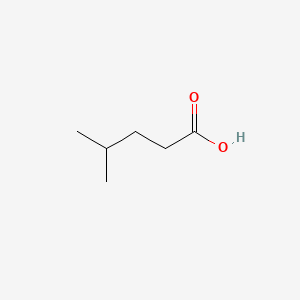| MeSH term | MeSH ID | Detail |
|---|---|---|
| Clostridium Infections | D003015 | 5 associated lipids |
| Diarrhea | D003967 | 32 associated lipids |
| Anemia, Sickle Cell | D000755 | 34 associated lipids |
| Occupational Diseases | D009784 | 42 associated lipids |
| Diabetes Mellitus, Type 1 | D003922 | 56 associated lipids |
| Diabetes Mellitus, Type 2 | D003924 | 87 associated lipids |
| Edema | D004487 | 152 associated lipids |
4-METHYLPENTANOIC ACID
4-METHYLPENTANOIC ACID is a lipid of Fatty Acyls (FA) class. The involved functions are known as CoA-transferase activity. 4-methylpentanoic acid often locates in Cytosol. The related lipids are Fatty Acids and alpha-ketocaproic acid.
Cross Reference
Introduction
To understand associated biological information of 4-METHYLPENTANOIC ACID, we collected biological information of abnormalities, associated pathways, cellular/molecular locations, biological functions, related genes/proteins, lipids and common seen animal/experimental models with organized paragraphs from literatures.
What diseases are associated with 4-METHYLPENTANOIC ACID?
There are no associated biomedical information in the current reference collection.
Possible diseases from mapped MeSH terms on references
We collected disease MeSH terms mapped to the references associated with 4-METHYLPENTANOIC ACID
PubChem Associated disorders and diseases
What pathways are associated with 4-METHYLPENTANOIC ACID
There are no associated biomedical information in the current reference collection.
PubChem Biomolecular Interactions and Pathways
Link to PubChem Biomolecular Interactions and PathwaysWhat cellular locations are associated with 4-METHYLPENTANOIC ACID?
Visualization in cellular structure
Associated locations are in red color. Not associated locations are in black.
Related references are published most in these journals:
| Location | Cross reference | Weighted score | Related literatures |
|---|
What functions are associated with 4-METHYLPENTANOIC ACID?
Related references are published most in these journals:
| Function | Cross reference | Weighted score | Related literatures |
|---|
What lipids are associated with 4-METHYLPENTANOIC ACID?
Related references are published most in these journals:
| Lipid concept | Cross reference | Weighted score | Related literatures |
|---|
What genes are associated with 4-METHYLPENTANOIC ACID?
There are no associated biomedical information in the current reference collection.
What common seen animal models are associated with 4-METHYLPENTANOIC ACID?
There are no associated biomedical information in the current reference collection.
NCBI Entrez Crosslinks
All references with 4-METHYLPENTANOIC ACID
Download all related citations| Authors | Title | Published | Journal | PubMed Link |
|---|---|---|---|---|
| Fujita Y et al. | Deorphanization of Dresden G protein-coupled receptor for an odorant receptor. | 2007 | J. Recept. Signal Transduct. Res. | pmid:17885925 |
| Campo E et al. | Solid phase extraction, multidimensional gas chromatography mass spectrometry determination of four novel aroma powerful ethyl esters. Assessment of their occurrence and importance in wine and other alcoholic beverages. | 2007 | J Chromatogr A | pmid:17137585 |
| Kim J et al. | Characterization of (R)-2-hydroxyisocaproate dehydrogenase and a family III coenzyme A transferase involved in reduction of L-leucine to isocaproate by Clostridium difficile. | 2006 | Appl. Environ. Microbiol. | pmid:16957230 |
| Portincasa P et al. | Liver breath tests non-invasively predict higher stages of non-alcoholic steatohepatitis. | 2006 | Clin. Sci. | pmid:16603025 |
| Homanics GE et al. | Production and characterization of murine models of classic and intermediate maple syrup urine disease. | 2006 | BMC Med. Genet. | pmid:16579849 |
| Goto M et al. | Structural determinants for branched-chain aminotransferase isozyme-specific inhibition by the anticonvulsant drug gabapentin. | 2005 | J. Biol. Chem. | pmid:16141215 |
| Colombo D et al. | Anti-tumor-promoting activity of simple models of galactoglycerolipids with branched and unsaturated acyl chains. | 2005 | Eur J Med Chem | pmid:15642411 |
| Nakai T et al. | Ligand-induced conformational changes and a reaction intermediate in branched-chain 2-oxo acid dehydrogenase (E1) from Thermus thermophilus HB8, as revealed by X-ray crystallography. | 2004 | J. Mol. Biol. | pmid:15033367 |
| Ohta K et al. | Separation and conductimetric detection of C1-C7 aliphatic monocarboxylic acids and C1-C7 aliphatic monoamines on unfunctionized polymethacrylate resin columns. | 2004 | J Chromatogr A | pmid:15250420 |
| Broadbent JR et al. | Overexpression of Lactobacillus casei D-hydroxyisocaproic acid dehydrogenase in cheddar cheese. | 2004 | Appl. Environ. Microbiol. | pmid:15294819 |
